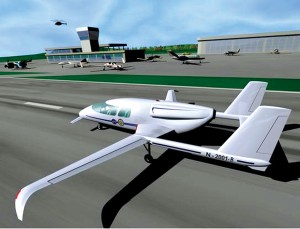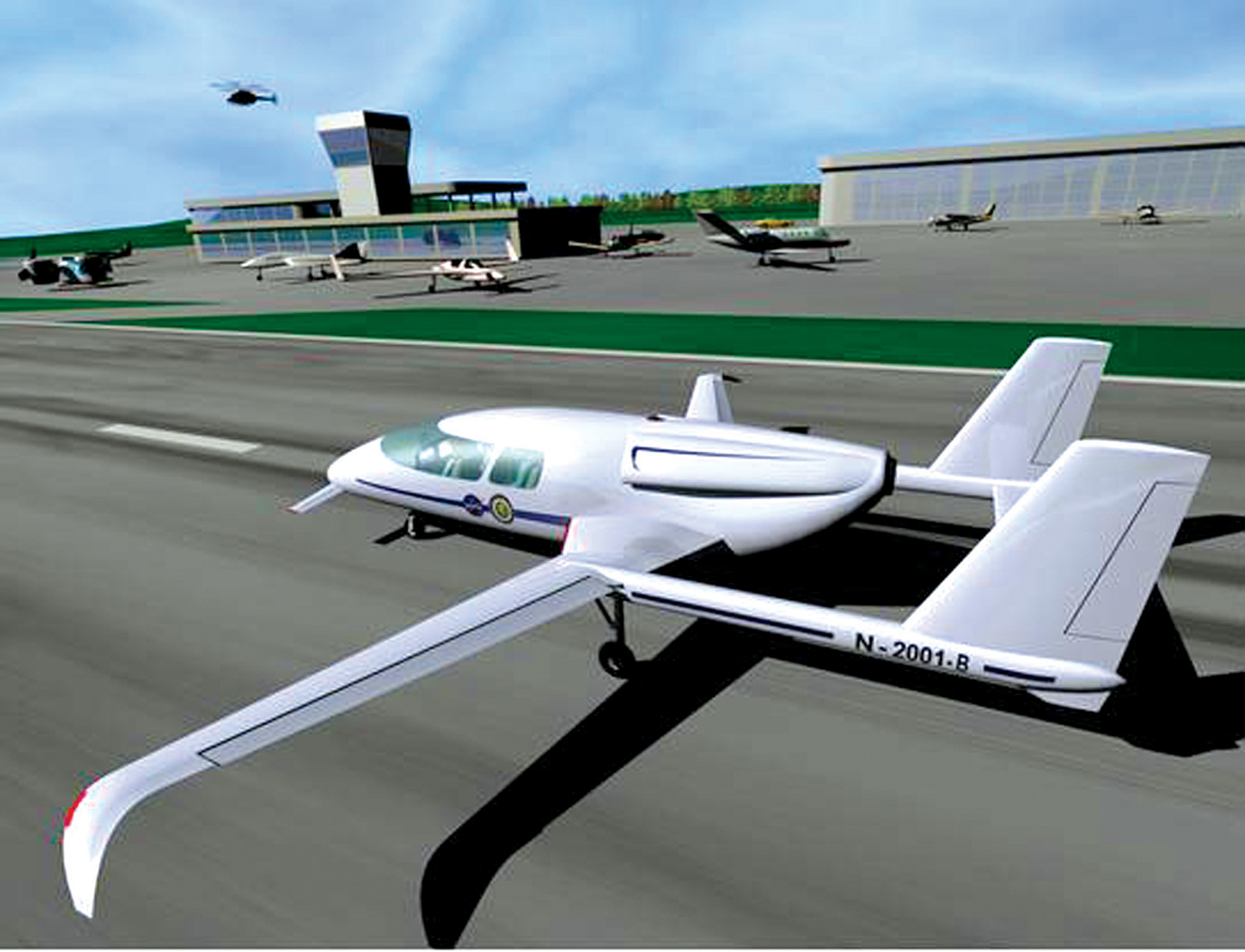By Chuck Weirauch

A future air taxi as envisioned by NASA takes off from a Small Aviation Transportation System enabled airport.
If you’re tired of fighting for airspace at today’s congested primary airports, think of what air traffic could be like when air taxi services begin operation in earnest within the next couple of years. These air services, flying the latest in very light jets and high-performance piston aircraft, could add a considerable burden on air traffic controllers and increase the competition for all airport services.
According to the Federal Aviation Administration, when the air taxi equation is added to the air traffic mix, regional hub-and-spoke airports in metropolitan areas are expected to experience a 300 percent increase in flight delays by 2010. If one doubts that estimate, consider that today there are orders from mainly air taxi services for 2,500 Eclipse 500 VLJs alone. That aircraft is expected to be certified next year, and several other manufacturers are nearing that milestone for their low-cost, next-generation, high-performance passenger airplanes.
CASA kickoff
“We have to make sure that this congestion problem doesn’t happen,” said Ray Wabler, president of Consortium for Aviation System Advancement. “We think that the answer to this problem is the Small Aircraft Transportation System.”
Wabler was addressing representatives of aircraft manufacturers, airport service providers and universities, along with aviation consultants, at the first organizational meeting for CASA held October 19 at the Crowne Plaza Hotel in Orlando. He provided attendees with an overview of the NASA-sponsored SATS program and the work of the
Southeast SATS Lab in Daytona Beach. Wabler also outlined how CASA will carry on the work of the SATS program, which ended in June of this year.
“In the 1950s, the Interstate Highway System put wheels on America and made it easy to get from one place to another,” Wabler said. “What we want to do is put wings on America and make it easier to get from one place to another, so you can go where you want to and not where the airline wants you to go, on your schedule.”
To accomplish that and to avoid hub-and-spoke regional airport congestion as well, SATS and now CASA is championing the use of secondary airports used primarily by general aviation as operational centers and destinations for air taxi services. These airports that serve smaller communities are an underrated and underused resource throughout the U.S. and in Florida in particular, Wabler said. They also can provide transportation much closer to air passengers’ final destinations, he added.
There are more than 150 such airports in Florida, one of the primary reasons why CASA representatives want to use the state as a testbed for new airport technologies
researched and developed under the SATS program. In essence, CASA is the promoter of the implementation phase of SATS R&D work. The organization also is promoting the application of the federal Next Generation Air Transportation System throughout Florida.
New airport technologies
The SATS technologies focus on meeting the problems commonly found at GA airports that have prevented their mainstream use. One of these problems is providing the approach, landing and navigational equipment, as well as air controller staff, required by the FAA for the 24-hour, all-weather operation that air taxi operators will demand.
To meet such needs, much of the SATS R&D work has focused on automated, stand-alone equipment that can convey such information to aircraft within the vicinity of the airport, as well as such products as low-cost, solar-powered runway lighting systems. According to Wabler, CASA was formed to make sure that the technological advances made through SATS research will not be lost to the aviation community because the SATS program has ended.
“Too much time and effort has gone into the SATS program to allow this work to be lost,” Wabler said. “Aircraft technology has evolved to provide single-pilot, high-performance, glass cockpit airplanes that can make the SATS program a reality, and technology for airports must evolve with it.”
Support for CASA
At the meeting, several former board members of the Southeast SATS Lab came forward to join the CASA Board of Directors. Although there wasn’t a high turnout at the gathering, Ken Stackpoole, Embry-Riddle SATS board representative and the university’s vice president for government relations, anticipated that more SATS board members will follow the initial move from SATS to CASA just as he and others have done.
Stackpoole explained that a major player in Southeast SATS Lab work has been the Florida Department of Transportation. This state agency provided approximately $7 million in funding throughout the course of the five-year SATS program. While Stackpoole said that the FDOT was expected to support CASA, it was unclear at the meeting as to whether the agency would provide any funding.
A mix of fixed base operators, airports, air and airport service providers, aircraft airframe and component manufacturers, academic institutions and various local government agencies has supported the SATS program. The former NASA-sponsored effort has also received endorsement from such organizations as the Florida Aviation Trades Association and the Florida Airports Council.
Airport council involvement
Peter Modys is a representative of the Florida Airports Council and former SATS board member who joined the CASA board at the October meeting. He is also aviation division director for Southwest Florida International Airport in Fort Meyers.
“The key reason why the Florida Airports Council has supported SATS and will continue to do so through CASA is that the program really needs airports,” Modys said. “There are hundreds of airports in Florida that are presently underused that have the capacity to support the SATS concept. These airports could become centers of commerce and economic development for their areas. ”
Before such economic development can take place, much work needs to be done to build up the infrastructure of these airports along with the implementation of SATS-related flight support technologies. This includes such things as transportation services to and from the airport, food and other onsite services, air passenger and freight-handling facilities and a general upgrading of overall airport facilities, CASA representatives say.
“Airports need to get ready for SATS, and this is going to be tough,” Modys said.
“Air taxis are already here, but many airports are not ready for them.”
For more information, visit [http://www.casa.aero/default.asp].











